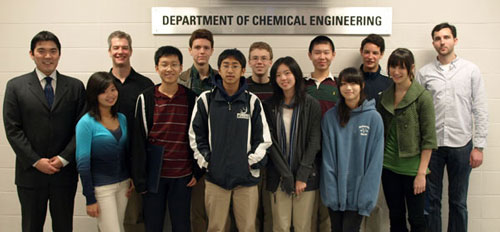Group:SMART:2010 Pingry SMART Team
From Proteopedia
| Line 96: | Line 96: | ||
== Substrate specificity == | == Substrate specificity == | ||
==='''A structure of an AKR with its substrate, 3-alpha-hydroxysteroid dihydrodiol dehydrogenase'''=== | ==='''A structure of an AKR with its substrate, 3-alpha-hydroxysteroid dihydrodiol dehydrogenase'''=== | ||
| - | <Ricardo, enter here> | + | <Ricardo, enter your introduction here> |
<applet load='1LWI_chainA.pdb' size='400' frame='true' align='left' caption='1lwi, Rat liver 3-alpha-hydroxysteroid dihydrodiol dehydrogenase with NADP+ cofactor' scene='2010_Pingry_SMART_Team/1lwi_default/1'/> | <applet load='1LWI_chainA.pdb' size='400' frame='true' align='left' caption='1lwi, Rat liver 3-alpha-hydroxysteroid dihydrodiol dehydrogenase with NADP+ cofactor' scene='2010_Pingry_SMART_Team/1lwi_default/1'/> | ||
====PDB ID: 1lwi, Rat liver 3-alpha-hydroxysteroid dihydrodiol dehydrogenase with NADP+ cofactor==== | ====PDB ID: 1lwi, Rat liver 3-alpha-hydroxysteroid dihydrodiol dehydrogenase with NADP+ cofactor==== | ||
| Line 102: | Line 102: | ||
| - | <applet load='1AFS_chainA.pdb' size='400' frame='true' align='left' caption='1afs, Rat liver 3-alpha-hydroxysteroid dihydrodiol dehydrogenase with cofactor and testosterone' scene='2010_Pingry_SMART_Team/1afs_default/ | + | <applet load='1AFS_chainA.pdb' size='400' frame='true' align='left' caption='1afs, Rat liver 3-alpha-hydroxysteroid dihydrodiol dehydrogenase with cofactor and testosterone' scene='2010_Pingry_SMART_Team/1afs_default/3'> |
====PDB ID: 1afs, Rat liver 3-alpha-hydroxysteroid dihydrodiol dehydrogenase with cofactor and testosterone==== | ====PDB ID: 1afs, Rat liver 3-alpha-hydroxysteroid dihydrodiol dehydrogenase with cofactor and testosterone==== | ||
{{Clear}} | {{Clear}} | ||
Revision as of 23:41, 8 January 2010
2010 Pingry S.M.A.R.T. Team, Protein Engineering; AKR's for Biofuel Cells
The 2010 Pingry School S.M.A.R.T. Team (Students Modeling A Research Topic) is working with Scott Banta at Columbia University to learn about enzymes being engineered for use in biofuel cells. Features being engineered into these enzymes include (1) self-assembly into hydrogels, (2) alternate cofactor use, and (3) broader substrate specificity. AdhD alcohol dehydrogenase from the thermophile Pyrococcus furiosus is one of the enzymes being engineered with these features by the Banta Lab. AdhD is a member of the aldo-keto reductase (AKR) family of oxidoreductases. Taking advantage of its innate thermostable properties, the Banta Lab is engineering AdhD for use in biofuel cells.The logical design and engineering of AdhD is based partially on the solved structures of other enzymes belonging to the AKR family of enzymes. Structures of mutants that bind alternate cofactors and those bound to its substrate provide insight into how to engineer AdhD and other enzymes of use in a biofuel cell. The 2010 Pingry S.M.A.R.T. Team is producing physical models of various AKR's that highlight the enzymes' structural and functional characteristics that are relevant to the Banta Lab's work.
What are S.M.A.R.T. Teams?
"S.M.A.R.T. Teams (Students Modeling A Research Topic) are teams of high school students and their teachers who are working with research scientists to design and construct physical models of the proteins or other molecular structures that are being investigated in their laboratories. SMART Teams use state-of-the-art molecular design software and rapid prototyping technologies to produce these unique models." -from the MSOE Center for BioMolecular Modeling Website.The S.M.A.R.T. Team program was supported in part by Grant Number 1 R25 RR022749-01 from the National Center for Research Resources (NCRR), a component of the National Institutes of Health (NIH), awarded to the Center for BioMolecular Modeling.
AdhD and Self-assembly into hydrogels
Cofactor specificity
Modifying cofactor specificity, 2,5-diketo-d-gluconic acid reductase
|
PDB ID: 1a80, 2,5-diketo-d-gluconic acid reductase with NADPH (wild-type)
Design description
Red and blue highlight the (alpha/beta)8 barrel structure typical of AKR's.
Cofactor (NADPH) shown in wireframe and colored CPK.
The backbone of the four residues changed between WT and NADP-binding mutant are colored orange (Lys232, Phe22, Arg238, Ala272).
Other residues highlighted by displaying sidechain:
Trp187; pi-stacking interaction with the nicotinamide ring of the cofactor.
Lys232, Ser233, Val234; interacts with phosphate group of NADPH
Not shown: Ala47 and Trp77; residues conserved in ADKR's Tyr50; Proton donor in AKR and part of catalytic triad and is conserved in all AKR proteins.
|
PDB ID: 1m9h, Mutant 2,5-diketo-d-gluconic acid reductase with NADH (mutant)
Design description
Red and blue highlight the (alpha/beta)8 barrel structure typical of AKR's.
Cofactor (NADH) shown in wireframe and colored CPK.
The backbone of the four residues changed between WT and NADP-binding mutant are colored orange (Lys232Gly, Phe22Tyr, Arg238His, Ala272Gly).
Lys232Gly mutation is important because Gly has no sidechain so there is nothing to interact with the absent phosphate group. Phe22Tyr mutation reduces the Km for both NADPH and NADH. Arg238His mutation forms a pi-stacking interaction to stabilize the AKR with the cofactor. Ala272Gly mutation improves the kinetic properties by making it easier for the substrate to bind with the substrate or by improving the kinetics of cofactor binding and release.
Other residues highlighted by displaying sidechain:
Trp187; pi-stacking interaction with cofactor
Not shown: Ala47 and Trp77; residues conserved in AKR's Tyr50; Proton donor in AKR and part of catalytic triad
Inherent dual cofactor use, Xylose reductase
|
PDB ID: 1k8c, Xylose reductase with NADP+
Pink and blue highlight the (alpha/beta)8 barrel structure of AKR's. Cofactor (NADP+) shown in wireframe and colored CPK.
The residues Glu227, Lys274, Ser275, Asn276, Arg280 have sidechains shown in wireframe and colored green.
Glu227-Changes its interactions with the cofactor depending upon if the cofactor is NAD or NADP, it has water-mediated reaction with the 3’ alcohol group on the ribose.
Lys274-interacts with the 2’ alcohol group on the NADP ribose but does not interact with the NAD cofactor
Ser275- interacts with an oxygen on the NADP ribose’s phosphate group but does not interact with the NAD cofactor
Asn276-hydrogen bonding interactions with the different cofactors change when the cofactor changes
Arg280-changes position and interacts differently with the two types of cofactors.
|
PDB ID: 1mi3, Xylose reductase with NAD+
Substrate specificity
A structure of an AKR with its substrate, 3-alpha-hydroxysteroid dihydrodiol dehydrogenase
<Ricardo, enter your introduction here>
|
PDB ID: 1lwi, Rat liver 3-alpha-hydroxysteroid dihydrodiol dehydrogenase with NADP+ cofactor
| |||||||||||
Proteopedia Page Contributors and Editors (what is this?)
Tommie Hata, Caryn Ha, Doug Ober, Mai-Lee Picard, Connie Wang, Ed Kong, Dylan Sun, Ed Xiao, Alexander Berchansky, Florence Ma, David Sukhin



